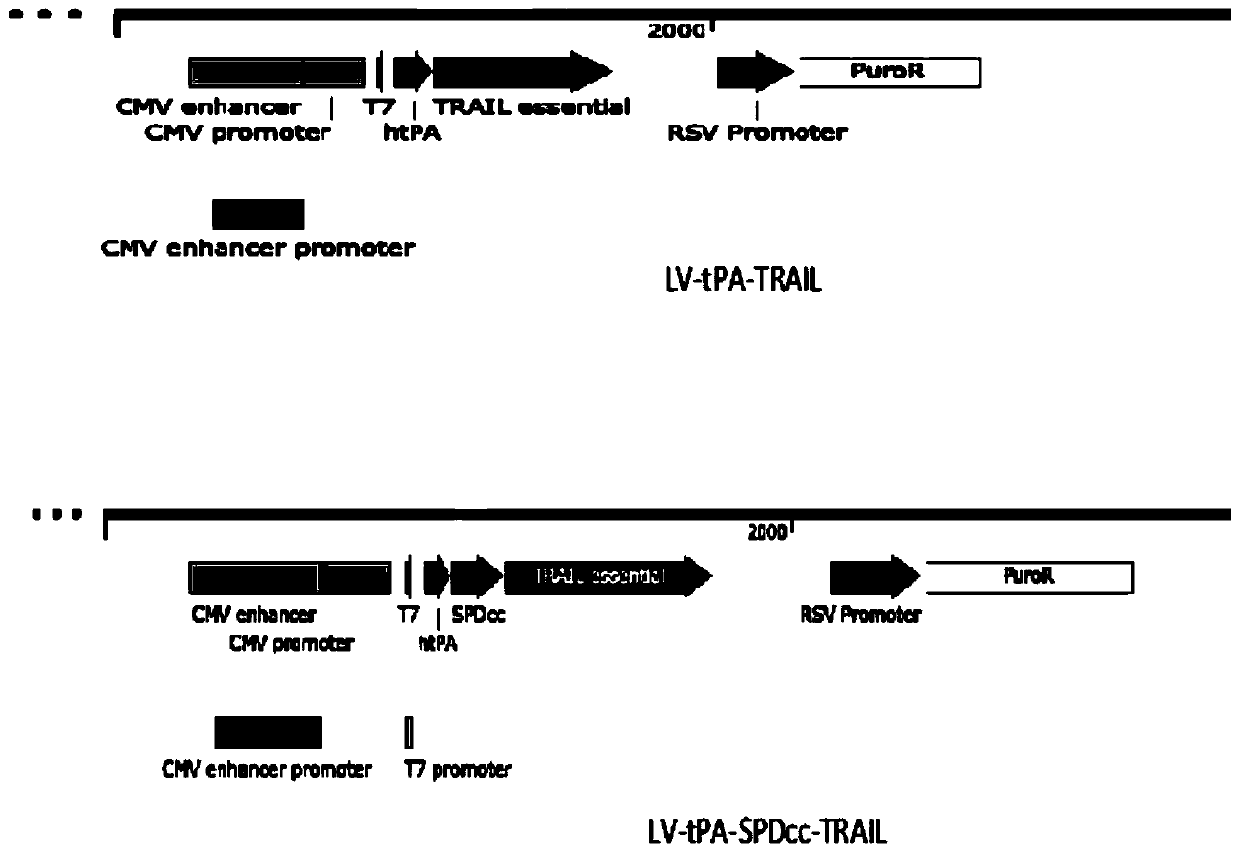Method for gene modification of mesenchymal stem cells through tripolymer TRAIL fusion protein, and application
A fusion protein, stem cell technology, applied to cells modified by introducing foreign genetic material, animal/human proteins, receptors/cell surface antigens/cell surface determinants, etc., can solve the problem of poor stability of trimeric TRAIL proteins, etc. question
- Summary
- Abstract
- Description
- Claims
- Application Information
AI Technical Summary
Problems solved by technology
Method used
Image
Examples
Embodiment 1
[0048] A trimeric TRAIL fusion protein whose nucleic acid sequence is as SEQID NO:1. The fusion protein includes:
[0049] The secretion signal protein is selected from tPA, IL-2 and SEC, preferably tPA, the nucleic acid sequence of which is as SEQ ID NO: 2;
[0050] Pulmonary surfactant protein-D (SPD), the coding region of which is the amino acid amino group of 224-255, and the nucleic acid sequence is shown in SEQ ID NO: 3;
[0051] The humanized tumor necrosis factor-related apoptosis inducing ligand (homo sapiens tumor necrosis factor-related apoptosis inducing ligand, hTRAIL) has a coding region of 114-281 amino acid residues, and the nucleic acid sequence is shown in SEQ ID NO: 4.
[0052] The preparation method of the trimeric TRAIL fusion protein includes the following steps:
[0053] (1) Design and gene synthesis of tPA, SPDcc, TRAIL and other gene sequences.
[0054] (2) Use molecular biology methods to connect tPA, SPDcc, TRAIL and other sequences in sequence into tPA-SPDcc-...
Embodiment 2
[0059] A method for modifying mesenchymal stem cells with trimer TRAIA fusion protein, including the following steps:
[0060] S1. Obtain the trimer TRAIL fusion protein;
[0061] Among them, the preparation method of the trimer TRAIL fusion protein is the same as in Example 1.
[0062] S2, the fusion protein is mixed with the auxiliary plasmid, and the cells are transfected;
[0063] Among them, the methods of transfection include virus transfection, liposome transfection, electrotransfer transfection, gene editing transfection and mRNA transfection.
[0064] The mixed culture of trimer TRAIL fusion protein and helper plasmid includes the following steps:
[0065] (1) Mix the fusion protein pellet with the auxiliary plasmids pMDLg, pRSV / REV, and pMDNA2.G, dissolve the mixed plasmid in Opti-MEM medium, and let it stand for 5 min;
[0066] (2) Join PLUS again TM Reagent, let stand for 5min;
[0067] (3) Put Mix the LTX reagent with the Opti-MEM solution, let stand for 5 minutes, and mix th...
Embodiment 3
[0079] Example 3. Detection of the stability of TRAIL protein secreted by genetically modified mesenchymal stem cells. The two genetically modified mesenchymal stem cell culture supernatants obtained in Example 2 were used and placed in a 37°C warm bath at different time intervals (0 , 24h, 48h, 72h and 96h) aspirate a small amount of supernatant and quickly store it in a refrigerator at -70℃. After sampling at all time points was completed, the TRAIL protein content of each sample was determined by the method described in Example 3.
[0080] Taking the protein content of each treatment group as %, calculate the residual rate of TRAIL protein at each time point in each treatment group according to the following formula:
[0081] Residual rate = (TRAIL concentration at each time point / 0h TRAIL concentration) x 100%
[0082] The results showed that compared with the control group (TRAIL gene modified MSC), the SPDcc-TRAIL gene modified MSC constructed by the method of the present inve...
PUM
| Property | Measurement | Unit |
|---|---|---|
| molecular weight | aaaaa | aaaaa |
| molecular weight | aaaaa | aaaaa |
Abstract
Description
Claims
Application Information
 Login to View More
Login to View More - R&D
- Intellectual Property
- Life Sciences
- Materials
- Tech Scout
- Unparalleled Data Quality
- Higher Quality Content
- 60% Fewer Hallucinations
Browse by: Latest US Patents, China's latest patents, Technical Efficacy Thesaurus, Application Domain, Technology Topic, Popular Technical Reports.
© 2025 PatSnap. All rights reserved.Legal|Privacy policy|Modern Slavery Act Transparency Statement|Sitemap|About US| Contact US: help@patsnap.com



